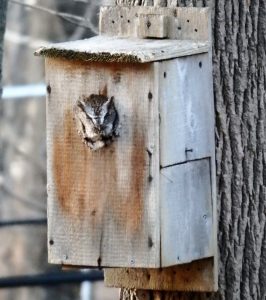Notes on Nest Box Placement
Because different species of birds prefer different kinds of nesting habitat, the habitat surrounding your box will play a role in determining which species will nest in it. You may be limited in the habitat you have available. Refer to the species habitat requirement below for more information. Typically, the box hole should face in a south-south east direction out of prevailing wind direction.
The table provides a concise description of nesting and habitat requirements for cavity-nesting birds that MAY utilize nest boxes
| Species | Nesting Habitat | Box Height | Box entrance Hole Size | Minimum Spacing |
| Black-capped Chickadee | forests, woodlots, and yards with mature hardwood trees, forest edges, meadows, area should receive 40-60% sunlight, hole should face away from prevailing wind; 1″ wood shavings can be placed in box | 5-15 feet | 1 1/8″ round | 1 box per 10 acres |
| Carolina Wren | forests with thick underbrush, forest edges, woodland clearings, open forests, shrub lands, suburban gardens, parks, backyards; near trees or tall shrubs | 5-10 feet | 1 1/2″ round | 200 feet |
| Eastern Bluebird | open field or lawn; orchards; open, rural country with scattered trees and low or sparse ground cover; entrance hole should face open field, preferring east, north, south, and then west facing directions | 3-6 feet | 1 1/2″ diameter | 300 feet |
| Eastern Screech Owl | forests, parks, woodland clearings, forest edges, yards, wooded stream edges, under a tree limb. Add 2″-3″ of wood shavings | 10-30 feet | 3″ round; not north facing | 100 feet |
| European Starling | habitat generalists, nesting in areas ranging from rural and agricultural to suburban and urban areas, but they avoid heavily wooded, mountainous, and arid regions. | providing nest boxes is discouraged for this species | can squeeze through holes with 1 9/16″ diameter | 5 feet |
| Great Crested Flycatcher | deciduous or mixed deciduous-coniferous forests, forest edges, woodlots, orchards, parks, on post or tree at forest edge | 3-20 feet | 1 9/16″ round | 1 box per 6 acres |
| House Sparrow | agricultural, suburban, and urban areas; tend to avoid woodlands, forests, grasslands, and deserts | providing nest boxes is discouraged for this species | can fit through holes with 1 1/2″ diameter | Variable |
| House Wren | variety of habitats, farmland, openings, open forests, forest edges, shrub lands, suburban gardens, parks, backyards; near trees or tall shrubs | 5-10 feet | 1 1/4″ round | 50 feet |
| Northern Flicker | pastures, groves, woodlots, orchards, fields, meadows, woodland clearings, forest edges, urban parks, on pole or tree at forest edge or along fence rows bordering crop fields; box should be completely filled with wood chips or shavings | 6-30 feet | 2 1/2″ round; southeast facing | 200 feet |
| Tree Swallow | open fields near water, expansive open areas, marshes, meadows, wooded swamps; on a post in open areas near tree or fence | 5-15 feet | 1 3/8″ round east facing | 30-100 feet |
| Tufted Titmouse | deciduous forest, thick timber stands, woodland clearings, forest edges, woodlots, riparian and mesquite habitats; spaced one box per 8 acres, hole should face away from prevailing wind | 5-15 feet | 1 1/4″ round | 1 box per 8 acres |
| White-breasted Nuthatch | deciduous woodlands, mature forests, woodlots, near open areas, forest edges, orchards, often near water; hole should face away from prevailing wind; 1″ wood shavings can be placed in box | 5-20 feet | 1 3/8″ round | 1 box per 25 acres |
| Wood Duck | forested wetlands or near marshes, swamps, and beaver ponds; place boxes in deciduous trees, 30-100 feet from the nearest water | 6-30 feet | 4″ wide, 3″ high | 600 feet |
Nest Box Predator Guards
Predators (e.g., raccoons, snakes, and feral cats), learn to associate nest boxes with prey. Therefore, installing predator guards underneath boxes will greatly increase nesting success. NJA strongly recommends installing predator guards. For small nest boxes, a PVC guard loosely hanging down from the box will provide a slippery and wobbling surface that feral cats and other predators can’t climb over. Making sure the top of the PVC fits close to the post will prevent snakes from accessing the nest boxes and will also avoid field mice and chipmunks from using the boxes. Larger boxes also need guards especially when over land. Predator guards for large boxes often consist of sheet metal wrapped around the pole or tree approximately 1 foot below the nest box. Nest boxes for screech owls are especially prone to squirrels in addition to predators and owlets often fall from the boxes and need to climb back up to the box so tree selection or predator guard design is important.
To make a predator guard go HERE
Nest Box Maintenance
Nest boxes need to be periodically monitored to remove unwanted species such as nonnative European house sparrows (Passer domesticus) and field mice and their nests, to remove paper wasps, to inspect that the boxes are in good condition, etc. Except for wood duck boxes, NJ Audubon recommends checking the boxes weekly between April and August. House sparrows are especially problematic and will try to nest in the boxes while also killing the adult and young of species, such as bluebirds, tree swallows and destroying their eggs. Old bird nests should be removed after the breeding season. Do not put nesting material in a nest box –bird will bring their own –EXCEPT for wood duck, kestrel, and screech owl. These boxes need a layer of wood chips-shavings at the bottom. DO NOT USE SAWDUST.
Wood Duck, Screech owl, and kestrel boxes can be cleaned and new wood shavings/chips (NOT SAWDUST) replaced in early fall – DO not disturb these boxes between February and August.






